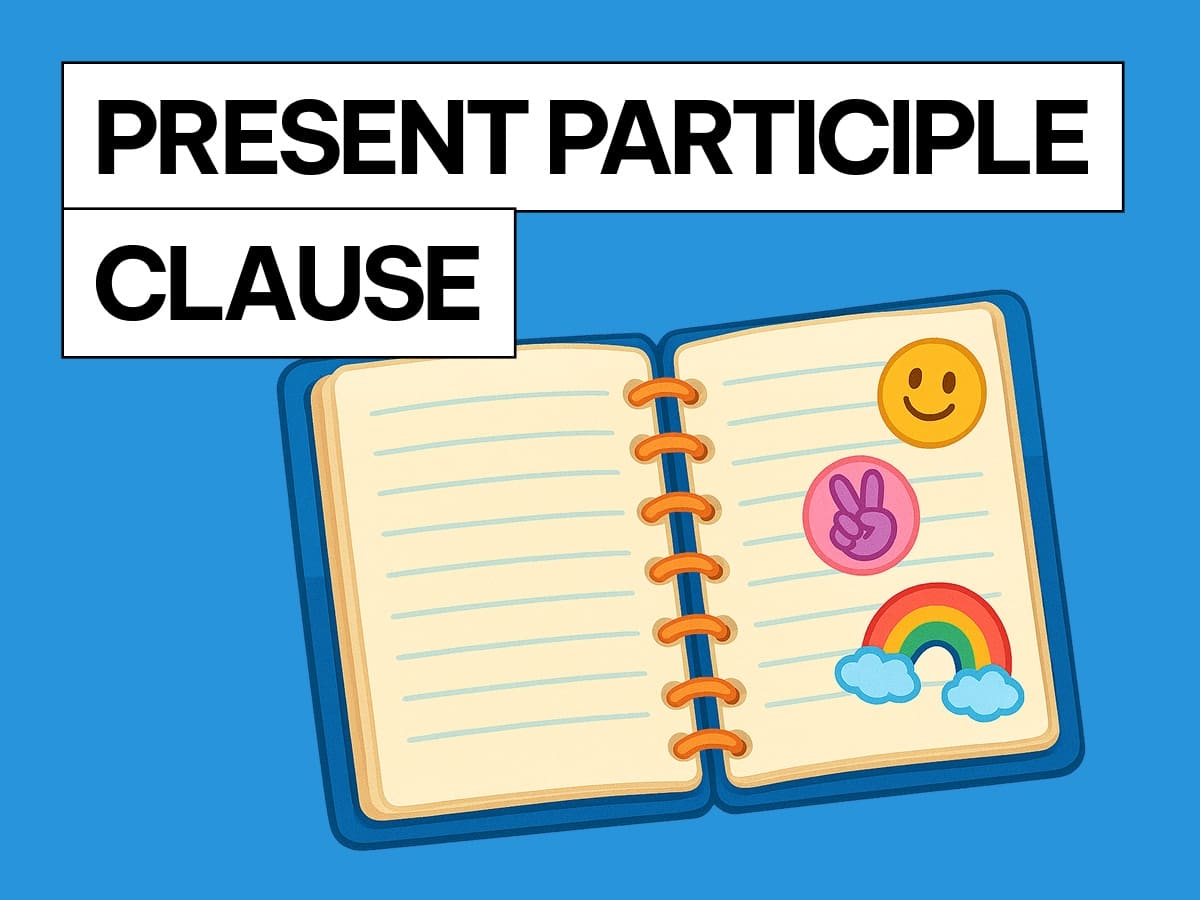Bài tập mệnh đề hiện tại phân từ (present participle clause) cơ bản và nâng cao
Mệnh đề hiện tại phân từ (present participle clause) là một công cụ hữu ích để tạo ra các câu văn ngắn gọn và giàu ý nghĩa hơn trong tiếng Anh. Việc sử dụng thành thạo loại mệnh đề này có thể giúp người học nâng cao kỹ năng viết và phân tích.
Hãy cùng DOL Grammar luyện tập qua các bài tập từ cơ bản đến nâng cao để làm chủ mệnh đề hiện tại phân từ nhé!

Ôn tập kiến thức mệnh đề hiện tại phân từ
Mệnh đề hiện tại phân từ là gì?
Mệnh đề hiện tại phân từ là dạng rút gọn của mệnh đề phụ trong câu phức, bắt đầu với động từ thêm -ing. Điều kiện để rút gọn là chủ ngữ của 2 mệnh đề phải giống nhau.
Cấu trúc cơ bản:
(Liên từ) + V-ing..., S + V
S + V + (Liên từ) + V-ing
S, (Liên từ) + V-ing..., V...
Mục đích sử dụng
A. Đưa ra kết quả của hành động
Ví dụ: The bomb exploded, causing many casualties. (Quả bom phát nổ, gây ra nhiều thương vong.)
B. Đưa ra nguyên nhân
Ví dụ: Negotiating skillfully, the diplomat resolved the conflict peacefully. (Đàm phán một cách khéo léo, nhà ngoại giao giải quyết mâu thuẫn một cách hòa bình.)
C. Diễn tả hành động xảy ra đồng thời
Ví dụ: I drove to work, singing along to my favorite song. (Tôi vừa lái xe đi làm vừa hát theo bài hát yêu thích của mình.)
D. Bổ sung thông tin cho chủ ngữ
Ví dụ: Starting from next month, a new policy will come into effect. (Bắt đầu từ tháng sau, một chính sách mới sẽ có hiệu lực.)
Chức năng
Chức năng như tính từ
Bổ nghĩa cho danh từ/cụm danh từ hoặc đại từ
Đứng ngay sau từ được bổ nghĩa
Chức năng như trạng từ
Đưa tin về thời gian, nguyên nhân, kết quả, điều kiện
Có thể đứng đầu hoặc cuối câu
Vị trí trong câu
Khi là trạng ngữ:
Có thể đứng trước hoặc sau mệnh đề chính
Phân cách bằng dấu phẩy
Khi là tính từ:
Đứng sau danh từ/đại từ được bổ nghĩa
Phân tách bằng dấu phẩy
Sau liên từ và giới từ:
Đứng sau before, after, instead of, on, since, when, while, và in spite of
Cách thành lập
Bước 1: Xác định điều kiện của câu
Phải là câu phức
Chủ ngữ hai mệnh đề phải giống nhau
Bước 2: Loại bỏ chủ ngữ ở mệnh đề phụ
Có thể loại bỏ liên từ nếu không ảnh hưởng nghĩa
Bước 3: Chuyển động từ
Bỏ trợ động từ
Chuyển động từ chính về dạng V-ing
Trên đây là những điểm ngữ pháp cơ bản để bạn có thể xem lại trước khi làm bài tập. Để tìm hiểu chi tiết hơn, bạn có thể đọc ngay bài viết lý thuyết Mệnh đề hiện tại phân từ tại kho tàng ngữ pháp DOL Grammar!
Bài tập mệnh đề hiện tại phân từ cơ bản và nâng cao
Bài tập cơ bản về mệnh đề hiện tại phân từ
Bài tập 1
Đề bài
Chọn mệnh đề hiện tại phân từ đúng để hoàn thành câu.
______, the ancient ruins revealed many historical secrets.
______, the company's profits increased significantly.
The document, ______, contains sensitive information.
______, Sarah still managed to complete the project on time.
The professor, ______, received a standing ovation.
______, the research team made several groundbreaking discoveries.
The evidence ______ suggests a different conclusion.
______, the artist could not complete his masterpiece.
The students, ______, showed significant improvement in their test scores.
______, the historic building now serves as a museum.
Bài tập 2
Đề bài
Hoàn thành các câu sau bằng cách sử dụng mệnh đề phân từ thích hợp. Các từ trong ngoặc là gợi ý.
Bài tập nâng cao về mệnh đề hiện tại phân từ
Bài tập 1
Đề bài
Sắp xếp các từ sau thành câu có nghĩa sử dụng mệnh đề phân từ. Điều chỉnh một số từ cho phù hợp.
carefully / planned / Having / proceeded / the / we / project
street / man / saw / down / walking / I / the / a
homework / not / teacher / understanding / asked / his / he / his
breakfast / having / morning / finished / left / early / she / for / work
door / standing / man / the / the / speaks / languages / at / three
tired / being / continued / from / work / she / still
book / found / interesting / the / reading / he / very / it
raining / house / heavily / left / the / she / despite
computer / repaired / having / started / the / work / he / to
parents / living / his / alone / misses / abroad / he
Bài tập 2
Đề bài
Chọn cách rút gọn đúng cho mỗi câu sau.
Because I had a lot of work to do, I couldn't attend the party.
When she finished her homework, she went to bed.
While he was watching TV, he fell asleep.
As he didn't know the way, he asked for directions.
After we had discussed the problem, we found a solution.
The student who is sitting in the front row is from Japan.
Although she was tired, she kept working.
Since I lived in Paris, I have learned to speak French fluently.
The man who works in the library helped me find the book.
As they didn't receive any response, they sent another email.
Bài tập 3
Đề bài
Viết lại câu sử dụng mệnh đề hiện tại phân từ.
Because he forgot his wallet, he couldn't pay for lunch.
While the teacher was explaining the lesson, the students took careful notes.
After she had checked all the details, she submitted the report.
When I saw her crying, I immediately went to comfort her.
Since I moved to this city, I have made many new friends.
Although he was suffering from a cold, he still went to work.
The man who is standing at the bus stop is my English teacher.
Because we arrived early at the airport, we had time for breakfast.
As she didn't understand the instructions, she made several mistakes.
Before he left the house, he double-checked all the windows.
Tổng kết
Mệnh đề hiện tại phân từ (present participle clause) là một công cụ ngữ pháp hữu ích giúp câu văn trở nên ngắn gọn, súc tích và mang tính học thuật hơn. Việc nắm vững cách sử dụng loại mệnh đề này không chỉ giúp người học cải thiện kỹ năng viết mà còn nâng cao khả năng phân tích và hiểu các văn bản tiếng Anh phức tạp. Bài viết đã cung cấp những kiến thức nền tảng và bài tập thực hành để hỗ trợ người học luyện tập và củng cố chủ đề này. Hãy luyện tập thường xuyên để có thể sử dụng mệnh đề hiện tại phân từ một cách linh hoạt và hiệu quả trong bài viết của bạn.
Bạn có thể tham khảo thêm các bài viết khác về ngữ pháp tiếng Anh tại https://grammar.dolenglish.vn/.

